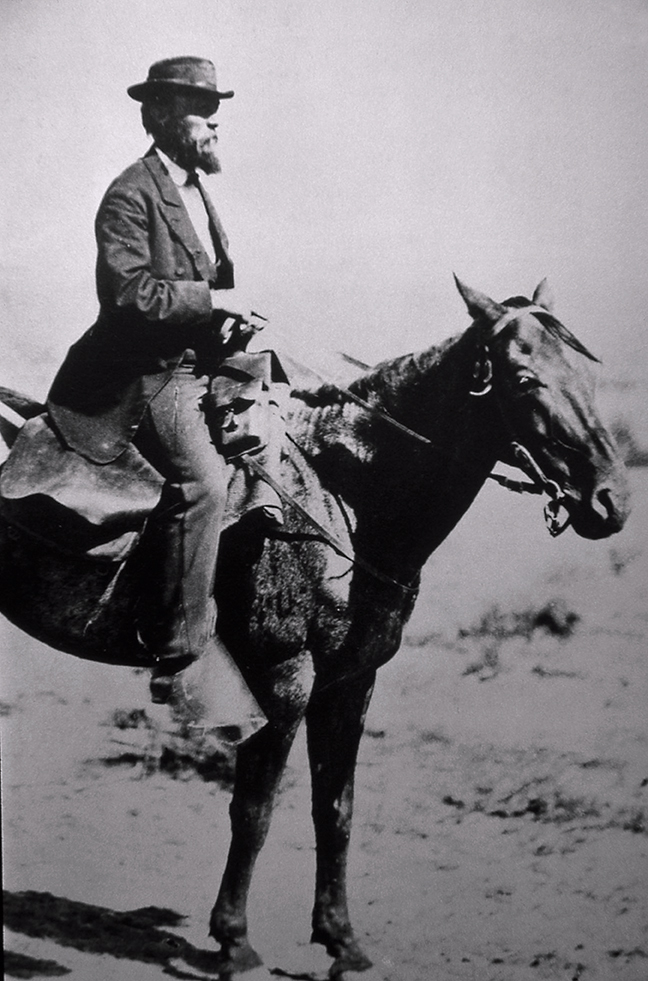
As the National Park Service marks its centennial this year, let’s take a moment to celebrate Penn professor and building namesake Ferdinand Hayden, whose visionary advocacy saved what became America’s first National Park from the tawdry, commercialized fate of Niagara Falls.
BY DENNIS DRABELLE
Photographs by William Jackson
Paintings by Thomas Moran
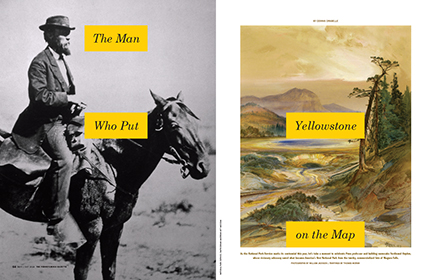
Ferdinand Vandeveer Hayden Hon1886, who taught at Penn and for whom Hayden Hall is named, was neither rich nor genteel. But at a time—the mid-19th century—when American science was the province of men born to well-off families and trained in Europe, Hayden transcended his limitations. Drawing on intelligence, managerial skills, a knack for publicity, and an appetite for fame, he forged an illustrious career as an explorer-scientist.
Hayden earned a reputation as a man on the make, but at a critical moment he exhibited the taste and foresight of a gentleman. In 1871, as he and the scientists and artists under his command explored Yellowstone country, its future hung in the balance. Would this stupendous assemblage of peaks and canyons, hot springs and geysers, go the shabby way of Niagara Falls, which Hayden knew from his young manhood in the East—its shoreline subdivided into a clutter of private holdings whose owners vied with one another to ensnare tourists? Or would the federal government step in to bar private claimants and set Yellowstone aside as a public sanctuary?
For Hayden the choice was clear. He shared an advance draft of his visionary report on Yellowstone with congressional committees and may have been the first to go public with the idea of making it a national park. Congress took his advice, setting a precedent for national ownership of splendid natural features. In Beyond the Hundredth Meridian, the writer and environmentalist Wallace Stegner summed up Hayden’s central role: “To [him], as much as to any other man, we owe the creation of Yellowstone National Park, which in 1872 became the foundation for all the future development of the park system.”
This year’s celebration of the 100th birthday of the National Park Service, which administers Yellowstone and its multitudinous progeny, is a fitting occasion to review Hayden’s life and work.
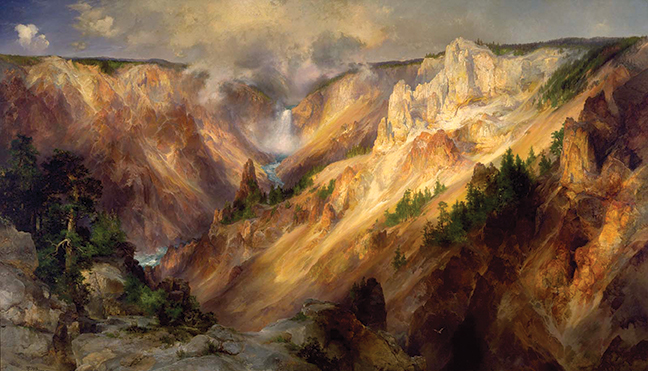
He had a fractured childhood. Born in western Massachusetts, probably in 1828, Ferdinand was 12 when his parents divorced and the boy was palmed off on his Aunt Lucretia in Rochester, Ohio. Although Lucretia turned out to be a kind and loving substitute parent, the uprooting left a scar. At age 16, Hayden showed up at Oberlin College, where the spottiness of his education relegated him to a preparatory track. Two years later, he was admitted to the college proper and graduated in 1850 with what he remembered as “a decided taste for the natural sciences.”
After teaching grammar school for a while, Hayden attended lectures at the Cleveland Medical School, then returned to the East and enrolled in the Albany Medical School, from which he graduated with an MD degree in 1854. (As was common at the time, he studied natural history, geology included, as part of the medical curriculum.) One of his academic mentors gave Hayden his start as an explorer-scientist by dispatching him to the Upper Missouri River Basin, where he collected fossils—among them the first American dinosaur fossils—and took notes on geology. He and his right-hand man, the geologist and paleontologist Fielding Meek, continued exploring on their own, racking up a total of almost two years in the field. It was during these travels that Sioux onlookers gave Hayden a nickname that nicely captures his time’s-a-wasting drive: “the man who picks up stones running.”
He also picked up money running: funds to support his expeditions. In what his biographer, Mike Foster, calls an unguarded moment, Hayden groused about having to do fieldwork on a tight budget: “I am treated here with respect, yet I am well aware that here a man without money is a bore, and with money [one becomes] a great gentleman let him do what he will. And my industry only makes me a greater bore … because they [the traders] can make no money out of me.” Despite the constraints, his and Meek’s reports on what they saw and collected were so well received that in 1856 Hayden was elected a corresponding member of the Philadelphia Academy of Natural Sciences.
That same year, he landed a job as geologist for an Army topographical survey that traveled as far as the Powder River in Wyoming and Montana. During this stint he got to know the legendary mountain man Jim Bridger, who regaled him with stories of Yellowstone’s pulsating landscape. Hayden vowed to see it for himself one day.
Back East, Hayden and Meek lined up more expeditions. These took the two men to the Black Hills and the Tetons, among other ranges, and in 1859 Hayden made a seminal contribution to American geology by intuiting that the whole Rocky Mountain chain was the result of a massive uplift.
Hayden continued to attract mentors, among them Joseph Leidy, a Penn professor who was perhaps the foremost natural scientist of his day (the subtitle of Leonard Warren’s 1998 biography of Leidy—The Last Man Who Knew Everything—gives a sense of his broad-gauge accomplishments). Though Hayden was essentially a loner, he knew how to ingratiate himself, flattering his targets so masterfully that they seemed unaware of being used until their usefulness expired, at which point Hayden dropped them. By the time the Civil War broke out, he was considered one of American’s most productive and versatile naturalists.
During the war Hayden reverted to being a physician. Enlisting in the Union Army, he served as a surgeon, the director of a hospital, and finally chief medical officer of the Army of the Shenandoah. He resigned shortly after Lee’s surrender to Grant in April of ’65. Later that year, thanks in part to Leidy’s support, Hayden was appointed auxiliary professor of geology and mineralogy in Penn’s Department of Medicine.
He seems to have enjoyed teaching, and the regular salary made for a welcome change. In 1871, at the age of 43, he married. But no classroom was big enough to hold his ego, and he left Penn in 1872. In the meantime, he’d entered the most illustrious phase of his career as an explorer with a practical bent.
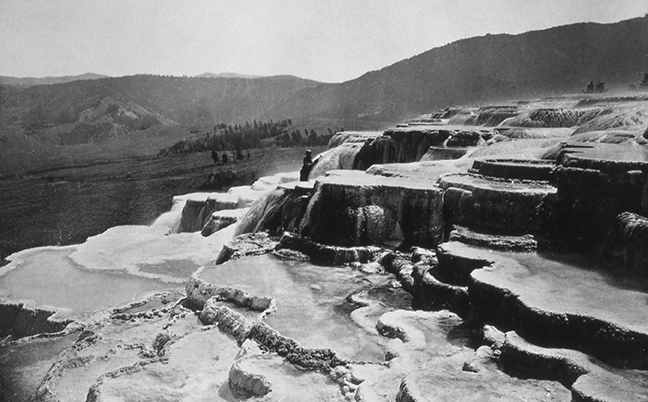
His surveys, lightly supervised by the Department of the Interior, retailed information on the installment plan. At the end of each season in the field, Hayden assembled and edited contributions from himself and his associates into a grand report—published at government expense—that summed up what they had found, mapped, and measured. In addition to fellow scientists, he relied on artists. Traveling with Hayden, Thomas Moran became one of the few painters able to capture not only the outsized physical reality of Western peaks and waterfalls, but also their romantic effect on the viewer. Hayden’s greatest discovery was William Henry Jackson, a transplanted Easterner who had made a success of his own photography studio in Omaha before answering the call of the open railroad: he took pictures of the brand-new Union Pacific line, sometimes from the dodgy vantage point of a train’s cow-catcher. He and Hayden had met at a Cheyenne brothel in 1869. Jackson was there to negotiate with the madam to take slice-of-life pictures; Hayden, presumably, was there for sex. Jackson worked for Hayden during most of the 1870s, and his photos for those surveys make a good case for him as the preeminent photographer of the Wild West.
Pitched to intelligent lay readers, Hayden’s reports became eagerly awaited annual events. The one for 1869 had a printing of 8,000 copies, but demand was so great that three weeks later they were all gone. Part of their appeal had to do with the flabbergasting wonders they described. Hayden was not the first to reach Yellowstone or Mesa Verde, to name just two of the sites associated with him. Others—Native Americans, fur trappers, missionaries, outlying settlers—had been there ahead of him. But unlike them, Hayden could command the attention of scientists, politicians, and the Eastern press. His “first” status lay in briefing the nation’s opinion makers on the West’s prodigious natural resources, not least its magnificent scenery.
In doing so, he exuded a contagious gusto. “To the geologist,” he wrote in one report, “Colorado is almost encyclopedic in its character, containing within its borders nearly every variety of geological formation.” In the preface to another report, he penned this rousing mission statement: “Never has my faith in the grand future that awaits the entire West been so strong as it is at the present time, and it is my earnest desire to devote the remainder of the working days of my life to the development of its scientific and material interests, until I shall see every Territory, which is now organized, a State of the Union.”
As that second quotation indicates, Hayden became the explorer as booster, “the businessman’s geologist,” as the historian William H. Goetzmann characterized him in Exploration and Empire: The Explorer and the Scientist in the Winning of the American West. In an era when the federal government was keen to settle and “civilize” the territories even as restless Easterners and Midwesterners itched to seek their fortunes on the frontier, Hayden and his helpers acted as an advance party, bringing order to the bewildering vastness beyond the 100th Meridian, sparing would-be settlers and developers the experience of westering in the dark, as it were.
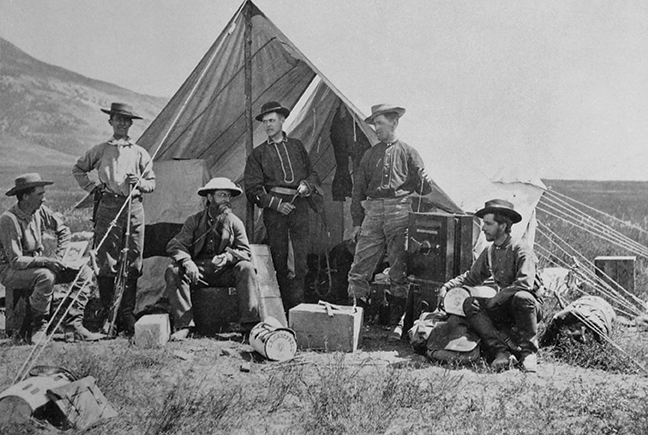
Two of his professional habits— his scientific analysis of sites others had tipped him off about, and his service to American commerce—came into play in the Yellowstone campaign. In 1871, after finally making good on his promise to investigate Yellowstone in person, Hayden saw to the creation and promulgation of maps that pulled the whole region together for the first time; and he wrote evocatively of the region’s incomparable natural features. For example:
The sides of the [geyser’s] basin are ornamented with coral-like forms, with a great variety of shades, from pure white to a bright cream-yellow, and the blue sky reflected in the transparent water gives an azure tint to the whole which surpasses all art. The little orifices from which the hot water issues are beautifully enameled with … porcelain-like lining, and around the edges a layer of sulphur is precipitated.
But the businessman’s geologist was no worshiper of mammon. Based on his own experience, he could tell you the likely fate of scenic treasures left to fend for themselves: piecemeal exploitation by myopic profit-seekers. In The National Parks: America’s Best Idea, the companion volume to Ken Burns’s PBS series of the same name [“Hymn to the Parks,” Sept|Oct 2009], Dayton Duncan C’71 summarizes Hayden’s position:
[He] warned [that] if Congress did not pass legislation protecting Yellowstone from private development, it would become another Niagara Falls. During his exploration, he noted, he had come across men cutting poles in anticipation of marking off the geyser basins and Mammoth Hot Springs for homestead claims. Prohibiting such settlement, he added, “takes nothing from the value of the public domain, and is no pecuniary loss to the Government, but will be regarded by the entire civilized world as a step of progress and an honor to Congress and the nation.”
Hayden worked with the Northern Pacific Railroad to push for national park status, which the far-sighted company realized would increase its revenues by making Yellowstone a magnet for tourists. Lawmakers’ minds were changed by Hayden’s advocacy, including his informed opinion that Yellowstone’s high elevation ruled it out as farmland; and their emotions were swayed by Moran’s artwork and Jackson’s photos, which were put on display in the halls of Congress. After passing both houses, the national park bill was signed into law by President Grant on March 1, 1872.
Hayden returned to Yellowstone a few months later, bringing with him more topographers and artists to flesh out and consolidate information on the new park. The following year he argued that the approach of railroads made exploration of Colorado Territory a must. Congress agreed, giving him a budget of $75,000. At one point Hayden found himself managing six separate Colorado parties as they faced multiple hazards, including lack of water, losing their way, forest fires, hostile Indians, and in one case a high-altitude electrical storm. “[A surveyor’s] tripod began to ‘click like a telegraph machine,’” Goetzmann wrote, “pencils in their hands chattered, and their hair emitted a sound ‘like frying bacon.’ … Together [the surveyors] slid down the mountain to safety just as a tremendous lightning bolt struck the bald summit where they had been.”
The Colorado project yielded more than just government reports. Hayden also oversaw the publication of a handsome book called Sun Pictures of Rocky Mountain Scenery (as of this writing, prices for the few copies available online range from $6,000 to $15,000), which introduced the public to Mesa Verde and the Mount of the Holy Cross, named after a striking pattern formed by snow-filled fissures on its upper slope. The group that explored Mesa Verde was headed by Jackson (Hayden was busy elsewhere). Again, they discovered nothing; the locals were well aware of the cliff dwellings’ existence. But Jackson’s fearless picture-taking—some of the ledges he crawled out on to get good shots were no more than 20 inches wide—brought national attention to a dramatic but little-known aspect of American Indian history. The effervescent Hayden went on to head special surveys of other prehistoric ruins in the Southwest, including Canyon de Chelly, Chaco Canyon, and Pueblo Pintado. Jackson not only photographed these sites; he also made models of them for display at the 1876 Centennial Exhibition in Philadelphia.
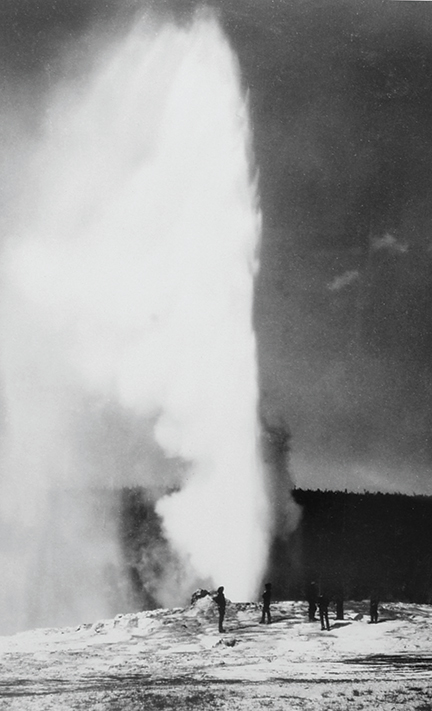
Hayden’s reputation was now at its zenith. The existence of rival and sometimes duplicative federal surveys had inspired a move to merge them into a single agency, and who was better-qualified than Hayden to be named its first director?
Yet what seemed the obvious choice bogged down in envy and politics. Some of his fellow scientists regarded Hayden as a facile generalist. One of them was John Wesley Powell, the geologist made famous by his heroic exploration of the Colorado River. Angling for the directorship himself, Powell accused Hayden of being “a charlatan” whose work was “noise and show.” Harvard’s president, Charles Eliot, weighed in, too, penning this sneering dismissal in a letter to President Rutherford B. Hayes: “I have often heard Dr. Hayden discussed among scientific men, but I have never heard either his attainments or his character spoken of with respect.” All those years later, Hayden was still pigeonholed as not one of “us.”
Hayden might still have won the prize: he enjoyed a good deal of support, especially among Westerners. But for once his enthusiasm deserted him. He was distracted and disheartened by an illness he’d contracted: locomotor ataxia, in all likelihood a manifestation of syphilis. He didn’t put up the vigorous fight expected of him, and directorship of the Geological Survey went to the well-connected geologist Clarence King. King resigned after less than two years in the job to concentrate on making a fortune as a mining entrepreneur. (He failed miserably; Hayden, for his part, refused to exploit his insider’s knowledge of Western natural resources for private gain.) Powell, who succeeded King, set the young agency on a firm, if sometimes controversial, course.
Hayden had meanwhile retired to Philadelphia, where he wrapped up work-in-progress and wrote portions of two books for a general audience. His health stabilized enough for him to make a few more Western field trips, and on one of these he took along his wife, Emma, on whom he’d increasingly come to rely.
In June of 1886, Penn awarded Hayden an honorary doctorate of laws.
After that his condition deteriorated, leaving him bedridden. He died on December 22, 1887, at the age of 59. By then the new age of academic specialization had reduced Hayden’s big-picture style of science almost to an anachronism. But any scientist of today who obtains a federal grant might well drink a toast to Hayden, whose exploring and popularizing helped make federal funding of science a habit. And if, as Burns and Duncan contend, the national parks are indeed America’s “best idea,” then Ferdinand Hayden has a good claim to be one of America’s best idea men.
Dennis Drabelle G’66 L’69 is the author, most recently, of The Great American Railroad War [“Arts,” Jan|Feb 2013].

